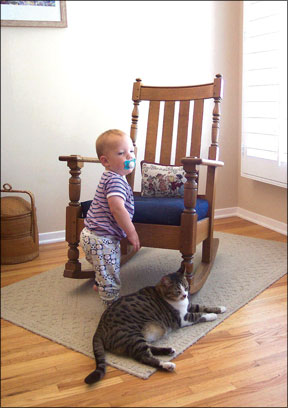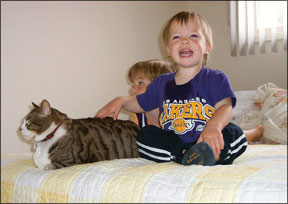I recently received a letter asking me whether there was any way to improve the relationship between a cat and a child. The question seems particularly relevant as we move beyond the holiday season and begin to plan for summer gatherings.
Our cats are important members of our families. We refrain from

Bev Caldwell
288
placing tinsel on our trees, since it is dangerous to our pets. Cats are invited to partake in holiday meals by sampling a bit of the roast in their bowls. We offer catnip as we sip our holiday wine. And yes, sometimes we fit our felines with antlers, halos and other festive garb.
Yet, from the cats point of view, there may be a downside to some of this celebration. Holidays that bring treat-bearing adults also bring children. Children, particularly those who do not live with cats of their own, can be overly eager to befriend the resident cat. Their overtures, combined with the barrage of activity and noise, can be overwhelming. Do we ask the children to stay home? Or do we just accept that our cats will remain hidden for hours while we attempt to make merry without them?
Of course, aggression that is provoked merely by the presence of a child is dangerous. If a cat poses a genuine risk to a child, stalking or lashing out even as the child sits quietly, minding his own business, the cat should be given nice, private accommodations for the duration of the visit. But in more normal cases it is sometimes possible to improve a cats opinion of a child through behavior modification.
Cats that are merely wary of children fall into one of two categories. There is the cat that makes himself invisible, spending the day or weekend under the bed or on the third floor of the house. And there is the cat that just pretends he is invisible. This cat may stay in the room, perched on a chair or shelf, not daring to move as he watches the child. Should the scary little person begin to approach, this cat might hiss or flee.
In either case, we are dealing with fear-based behavior, which may involve fear-based aggression, behaviors that may be treatable by means of a well implemented program of behavior modification. Most behavior modification programs are designed to effect slow but steady progress, however, so it will be difficult to make effective use of such techniques if the child visits only occasionally. Indeed, the less frequently a child visits, the more difficult it will be to change the cats opinion of him.
Pets and Kids Need to Be Kept Safe
The cardinal rule of therapy is that no one should be harmed. The focus of therapy is to reduce the cats fear at a comfortable pace. The stimulation must not be intense enough to cause the cat to panic and flee.

Bev Caldwell
288
Encouraging a cat to remain close to a fear-inducing trigger may be easier said than done. It is dangerous to restrain a cat that is terribly frightened. A physical barrier such as a double gate or screen door may be used to keep a cat from leaving the area while reducing the risk that a person could be injured.
During the first sessions, the child should simply sit quietly on his side of the screen. Meanwhile, the cat may move about on his own side of the barrier. He will look, listen and sniff, habituating himself to the presence of the visitor. Provide him with delicious food, interesting toys and resting places at various heights.
Always end a session on a positive note. That will almost certainly mean taking the cat back to his quiet space once the child becomes restless. As the lessons progress, the child may be invited to move about and play in the cats presence.
Once the cat is eating and/or playing without regard to the child, the screen may be removed. Again, have the child sit quietly. He may keep a warm fleece on the couch to passively encourage the cat to approach. There should be no attempt to coax or reach for the cat. These gestures will be intimidating. Instead, tidbits of food may be placed on the ground at random intervals.
When the child needs to get up, you may need to take the cat out of the area first so that he does not bolt. Remember: Do not end a session with a fearful cat. With successive successful sessions, the child will be able to stand and move about, dropping treats or tossing some cat toys.
Consider your cats pleasures and allow the child to be the source of those pleasures. With patience, your cat should begin to approach the child, eagerly awaiting some delicious food, a warm snuggle or an opportunity to play.



